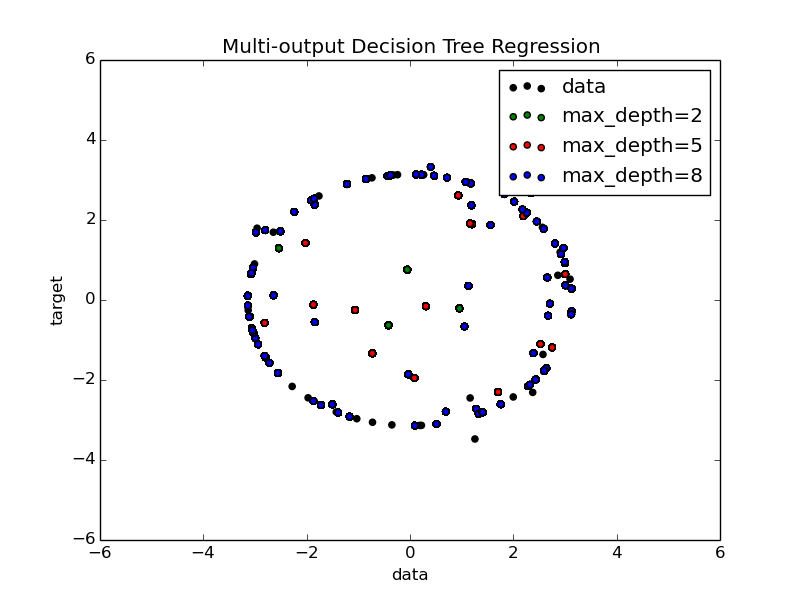Multi-output Decision Tree Regression¶
An example to illustrate multi-output regression with decision tree.
The decision trees is used to predict simultaneously the noisy x and y observations of a circle given a single underlying feature. As a result, it learns local linear regressions approximating the circle.
We can see that if the maximum depth of the tree (controlled by the max_depth parameter) is set too high, the decision trees learn too fine details of the training data and learn from the noise, i.e. they overfit.

Python source code: plot_tree_regression_multioutput.py
print(__doc__)
import numpy as np
import matplotlib.pyplot as plt
from sklearn.tree import DecisionTreeRegressor
# Create a random dataset
rng = np.random.RandomState(1)
X = np.sort(200 * rng.rand(100, 1) - 100, axis=0)
y = np.array([np.pi * np.sin(X).ravel(), np.pi * np.cos(X).ravel()]).T
y[::5, :] += (0.5 - rng.rand(20, 2))
# Fit regression model
clf_1 = DecisionTreeRegressor(max_depth=2)
clf_2 = DecisionTreeRegressor(max_depth=5)
clf_3 = DecisionTreeRegressor(max_depth=8)
clf_1.fit(X, y)
clf_2.fit(X, y)
clf_3.fit(X, y)
# Predict
X_test = np.arange(-100.0, 100.0, 0.01)[:, np.newaxis]
y_1 = clf_1.predict(X_test)
y_2 = clf_2.predict(X_test)
y_3 = clf_3.predict(X_test)
# Plot the results
plt.figure()
plt.scatter(y[:, 0], y[:, 1], c="k", label="data")
plt.scatter(y_1[:, 0], y_1[:, 1], c="g", label="max_depth=2")
plt.scatter(y_2[:, 0], y_2[:, 1], c="r", label="max_depth=5")
plt.scatter(y_3[:, 0], y_3[:, 1], c="b", label="max_depth=8")
plt.xlim([-6, 6])
plt.ylim([-6, 6])
plt.xlabel("data")
plt.ylabel("target")
plt.title("Multi-output Decision Tree Regression")
plt.legend()
plt.show()
Total running time of the example: 0.39 seconds ( 0 minutes 0.39 seconds)

